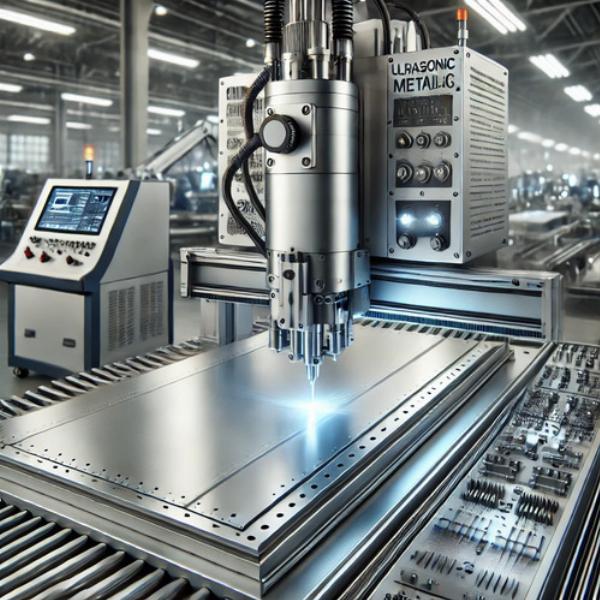Ultrasonic Metal Welding Machine Market: Perfect for Thin Metals

Strong 8k brings an ultra-HD IPTV experience to your living room and your pocket.
The Ultrasonic Metal Welding Machine Market has experienced significant growth over the past decade, primarily driven by the increasing demand for high-precision, eco-friendly and reliable joining methods. Ultrasonic metal welding has become an ideal solution for thin metals, finding widespread applications across various industries such as automotive, electronics, aerospace and medical devices. This article will explore the key aspects of ultrasonic metal welding machines, their benefits, market drivers and future trends, making them the perfect tool for thin metal welding.
Introduction to Ultrasonic Metal Welding Machine
Ultrasonic metal welding is a solid-state welding process that joins metals through high-frequency ultrasonic vibrations, typically ranging between 20 kHz and 70 kHz. The process does not require external heat, which reduces the risk of material distortion and degradation. Instead, the welding occurs due to frictional heat generated by the ultrasonic vibrations. This method is particularly useful for thin metals, as it ensures precision and integrity without compromising the metal's properties.
Why Ultrasonic Metal Welding is Perfect for Thin Metals
Precision and Clean Joints: Ultrasonic metal welding is highly accurate, providing clean and consistent joints, especially in thin metal applications like copper, aluminum and stainless steel. The process minimizes excess heat, which prevents warping or weakening of delicate materials.
No Additional Materials Required: Unlike other welding methods that require fillers or adhesives, ultrasonic welding uses no additional materials, which helps preserve the purity and conductivity of the metals involved.
Fast and Efficient: The welding process is incredibly quick, often taking less than a second to complete, making it ideal for high-volume production lines, especially in the electronics and automotive industries.
Environmentally Friendly: Ultrasonic welding produces no harmful fumes or residues, reducing the environmental impact of the welding process. It also minimizes energy consumption since no external heating is required.
Market Drivers for Ultrasonic Metal Welding Machines
Demand in the Automotive Industry: The growing trend toward electric vehicles (EVs) has significantly boosted the demand for ultrasonic metal welding. Thin metal components, such as battery connectors and wiring harnesses, require precise welding solutions that can be quickly and efficiently produced, making ultrasonic welding the ideal technology for EV manufacturing.
Growth in the Electronics Sector: Ultrasonic welding is crucial in assembling small and delicate electronic components, such as microcircuits and sensors. With the increasing miniaturization of electronic devices, the need for reliable and precise welding methods continues to grow, driving demand in this market.
Sustainability Initiatives: The push for greener manufacturing practices has increased the demand for processes that reduce waste, energy consumption and environmental impact. Ultrasonic metal welding meets these requirements, making it an attractive option for companies looking to enhance their sustainability efforts.
Medical Devices Industry: In the medical field, ultrasonic welding is used for assembling small metal parts, such as surgical tools, pacemaker components and other precision instruments. The process ensures sterile and precise joints, vital in producing high-quality medical devices.
Challenges and Opportunities
While ultrasonic metal welding offers many advantages, it is not without its challenges. The process is typically best suited for metals with similar melting points and may struggle with thicker materials or dissimilar metal combinations. Additionally, initial investment costs for ultrasonic welding machines can be high, limiting adoption in smaller-scale operations.
However, advancements in ultrasonic welding technology continue to address these limitations. Manufacturers are developing machines with greater flexibility, improved automation features and better control systems, allowing the process to handle a wider variety of metals and applications. This evolution presents opportunities for further market expansion.
Key Market Players
Branson Ultrasonics: A key player in the ultrasonic welding industry, offering a wide range of machines tailored for various applications, including thin metal welding.
Herrmann Ultrasonics: Known for innovative ultrasonic welding solutions, especially in automotive and medical device manufacturing.
Dukane Corporation: Specializes in providing ultrasonic welding solutions for the electronics and automotive industries, focusing on precision and reliability.
Future Growth Prospects
The ultrasonic metal welding machine market is expected to continue its upward trajectory, with a projected compound annual growth rate (CAGR) of around 6-8% over the next five years. The increasing demand for lightweight materials in the automotive and aerospace industries, combined with the push for sustainable manufacturing processes, will drive the market forward. As manufacturers continue to innovate and refine the technology, ultrasonic metal welding is poised to become even more versatile, expanding its applications across a wider range of industries.
Conclusion
Ultrasonic metal welding machines are the perfect solution for thin metal applications, offering high precision, speed and environmental benefits. As industries such as automotive, electronics and medical devices continue to grow, the demand for reliable, efficient and eco-friendly welding solutions will ensure a bright future for the ultrasonic metal welding machine market.
By embracing the latest advancements in ultrasonic welding technology, companies can stay ahead of the curve, ensuring they meet the ever-evolving needs of their respective industries. The continued growth of this market highlights the increasing importance of ultrasonic welding in modern manufacturing, making it a critical tool for the future of thin metal welding.
Note: IndiBlogHub features both user-submitted and editorial content. We do not verify third-party contributions. Read our Disclaimer and Privacy Policyfor details.






